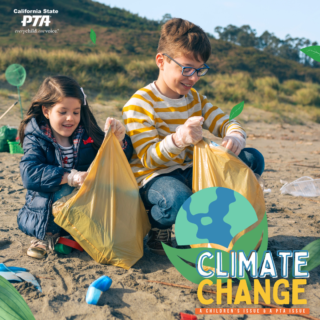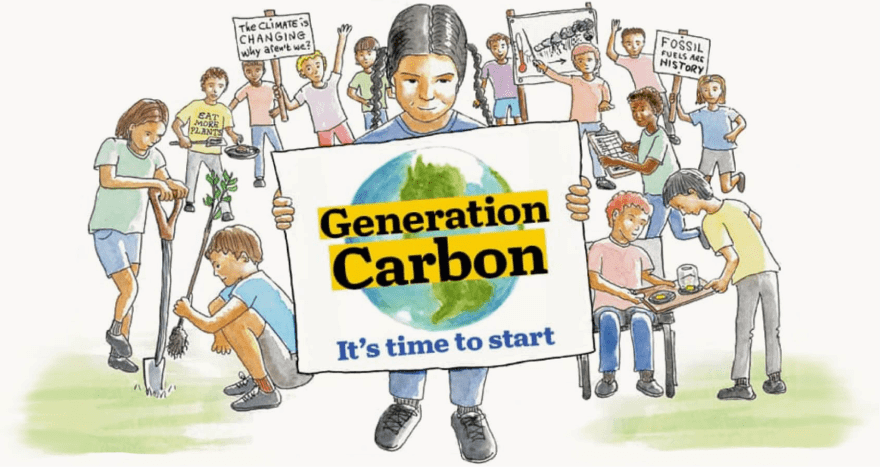 PTA has long worked to empower families, children, and young people to make positive changes in their lives, in their communities, and ultimately the world. One of the many complex issues that we face today is climate change. It’s an issue that California State PTA is committed to addressing.Our children and young people are well aware of the harmful effects of climate change. They learn about it through social media, the news, and conversations with friends and family. Many are also experiencing it first hand.
PTA has long worked to empower families, children, and young people to make positive changes in their lives, in their communities, and ultimately the world. One of the many complex issues that we face today is climate change. It’s an issue that California State PTA is committed to addressing.Our children and young people are well aware of the harmful effects of climate change. They learn about it through social media, the news, and conversations with friends and family. Many are also experiencing it first hand.
The sheer scale of this challenge can be overwhelming. Engaging and empowering your local community on this issue, however, does not need to be. A good way to keep work on climate change manageable is to keep it local. Working with local schools to address climate goals, and including students, families, local communities, and businesses, creates positive energy for change.
PTAs Have the Authority To Lead Community Efforts on Climate
In recent years, delegates to the California State PTA convention have adopted resolutions that provide every PTA with the authority needed to take a stand regarding climate change:
- Climate Change is a Children’s Issue (adopted in 2015) calls for PTAs in California to educate families about climate issues and to urge school districts to both educate students and make local schools more climate safe and energy efficient.
- Net Zero Emission Schools (adopted in 2020) addresses changes in school facilities and operations needed to specifically reduce the greenhouse gas emissions which are causing climate change.
Steps to Take
You may already be serious about climate change as an issue. Perhaps you’ve taken some steps to change your own and your family’s impact. If so, you are like the vast majority of people in the United States and the world according to opinion research. You are also probably like two out of three people who seldom talk about climate issues. It’s time to start having those conversations! A great place to start is by learning more about the science, the impact school systems have, and what is happening right in your own backyard.
Learn More About Climate Change Issues and Solutions
A quick search of the internet for “climate change” could leave your head spinning. An easy, trustworthy place to start is The Carbon Almanac. This book was written for people concerned about climate change but either unsure of the facts or frustrated trying to talk about it. The authors describe it as “the definitive source for facts and the foundation for a global movement to fight climate change.”
Supplemental materials on The Carbon Almanac website are great for taking next steps. The Educator’s Guide helps teachers turn some of the content into lesson plans. One of the most exciting resources is a kids’ book called Generation Carbon.
The ebook is available as a free downloadable PDF in English and a growing number of translations. The basic premise is that kids can use the book to teach adults the facts. (A print edition is also available.)
Become Familiar with How Schools Can Make a Difference
The nonprofit organization UndauntedK12 reports that “TK-12 education is one of California’s largest sectors of public infrastructure.” The state’s more than 10,000 public schools:
- Occupy 730 million square feet of buildings and 130,000 acres of land.
- Provide transportation to more than 1.1 million California students using 24,000 school buses.
- Provide hundreds of millions of meals each year to their students.
All of that means our local schools can make a huge impact on climate change based on how they run their operations. In addition, educating students about the environment and climate change is not only relevant and motivating for them, it’s built into California’s curriculum expectations. Information about the state’s support of environmental literacy and the multitude of available resources is available on the California Department of Education website.
In its 2021 K12 Climate Action Plan the Aspen Institute provides a framework for thinking broadly about “the opportunity for America’s K through 12th grade education sector to join the fight against climate change.”
The education of students and adults is front and center in this plan, which calls for efforts “across disciplines and educational settings” including in classrooms, expanded learning programs and in community-based programs such as museums and science centers. “Each educational setting has unique opportunities to engage students by helping them make connections between their own experiences and academic content.” Particular attention needs to be placed on issues of educational equity given that low-income communities are generally more vulnerable to adverse climate impacts.
To address the carbon imprint that school buildings and operations create, the Aspen Institute recommends actions at the local, state, and federal levels:
- Switch to renewable energy. In 2021, just 7% of schools nationally used solar power.
- Transition school buses to clean fuels. 94% of the country’s 480,000 school buses burned diesel.
- Reduce food waste and source school meals locally. Schools in the U.S. served approximately 7 billion meals annually in 2021. California schools alone provide free meal service to as many as five million students.
Schools also need to plan ahead for how they will support their students and sustain their communities as the climate changes. For example:
- Plan for extreme weather events, which can impact students’ physical and mental health, their academic progress, and their safety.
- Be proactive before an emergency. Create partnerships with nearby districts, provide tiered supports, and train educators and school staff on trauma-informed practices and eco-anxiety.
- Leverage school grounds. Adaptation planning can help reduce community heat and flooding and increase access to green space.
Find Out What’s Happening in Your Local Schools
The annual carbon footprint of the average Californian is about 9.1 metric tons — more than the mass of a huge elephant. Most schools are part of the problem, though some are ahead of the curve. Solar panels are a common sight on school grounds in many communities. A growing number of schools are implementing California’s environmental literacy curriculums and the state has provided some funding to support that. The state also has systems in place to support schools during climate emergencies.
Have your public schools gone as far as they can or should? Are they resting on their laurels? Active parent organizations can bring attention to the opportunity local schools have to advance climate solutions, beginning by directing to school district officials questions like these:
- Where can parents and students find the comprehensive climate action plans for their school?
- How will students, families, and community members be engaged in the development of future plans?
- What strategies are in place to transition to clean energy and clean transportation?
- What is being done to reduce food waste and use local food sources?
- How is the district measuring indoor air quality and drinking water safety? What is the plan to mitigate shortcomings?
- How is the district assessing local climate risks? What are the plans to prepare, adapt and build resilience to climate change?
- How well is teaching and learning about climate change integrated into the curriculum? Is there a plan for strengthening this integration if needed?
- How do plans and actions address equity, including the specific needs of families and communities likely to be disproportionately impacted by climate change?
- What is the carbon footprint per student at our school? What are the major contributors?
The California School Boards Association has a wealth of resources PTAs can use to inform such conversations and encourage action on climate issues among local school officials.
On the California State PTA Leaders Website you’ll find resources to help you create and implement the Climate Action program that’s right for your PTA, your school, and the children in your community.
Please reach out to the Health and Community Concerns Commission for assistance. Health@capta.org or CommunityConcerns@capta.org.
Some of the information on this page first appeared in this blog post on Ed100.
